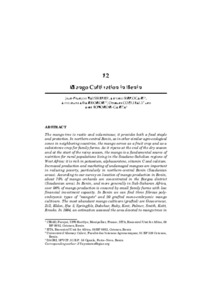| dc.contributor.author | Vayssières, J.F. |
| dc.contributor.author | Sinzogan, A.A.C. |
| dc.contributor.author | Adandonon, A. |
| dc.contributor.author | Coulibaly, O. |
| dc.contributor.author | Bokonon-Ganta, A.H. |
| dc.date.accessioned | 2019-12-04T11:07:54Z |
| dc.date.available | 2019-12-04T11:07:54Z |
| dc.date.issued | 2012 |
| dc.identifier.citation | Vayssières, J.F., Sinzogan, A.A.C., Adandonon, A., & Coulibaly, O. (2012). Mango cultivation in Benin. Houston: Studium Press LLC. |
| dc.identifier.isbn | 1-933699-94-9 |
| dc.identifier.uri | https://hdl.handle.net/20.500.12478/1644 |
| dc.description.abstract | The mango tree is rustic and voluminous; it provides both a food staple and protection. In northern-central Benin, as in other similar agro-ecological zones in neighboring countries, the mango serves as a fruit crop and as a subsistence crop for family farms. As it ripens at the end of the dry season and at the start of the rainy season, the mango is a fundamental source of
nutrition for rural populations living in the Soudano-Sahelian regions of West Africa: it is rich in potassium, alphacarotene, vitamin C and calcium. Increased production and marketing of undamaged mangoes are important in reducing poverty, particularly in northern-central Benin (Soudanian areas). According to our survey on location of mango production in Benin,
about 75% of mango orchards are concentrated in the Borgou district (Soudanian area). In Benin, and more generally in Sub-Saharan Africa, over 90% of mango production is ensured by small family farms with low financial investment capacity. In Benin we can find three fibrous polyembryonic types of “mangots” and 29 grafted mono-embryonic mango cultivars. The most abundant mango cultivars (grafted) are Gouverneur, Zill, Eldon, Ifac 3, Springfels, Dabshar, Ruby, Kent, Palmer, Smith, Keitt,
Brooks. In 1994, an estimation assessed the area devoted to mango trees in Benin at 1191 ha, total production being 10,166 t, and average yield per ha being 8.5 t. Assessments reveal that Beninese mango producers are confronted with three main connected problems namely (i) deterioration of fruit quality due to fruit flies, (ii) saturation of the national market leading to wastage and lower prices and (iii) lack of post-harvest promotion. More than 60% of mango orchards belong to the “Gatherer production system” in Borgou district. Mango-infesting fruit flies as Ceratitis cosyra and Bactrocera invadens (Diptera Tephritidae) became the target pests in Benin as in other West African countries. About the fruit fly issue, IITA-CIRAD has developed a Regional Fruit Fly Control Project also called West African Fruit Fly Initiative (WAFFI) based at the IITA station of Cotonou. WAFFI has developed Researches for Development in Benin and is proposing an IPM-package to control/reduce the damage of fly species by taking into account the socio-economic aspect of the method at producer level. Mango fruit processing overcomes many post-harvest problems and add value to the product. Currently, it may be noted that in Benin, the share of processed fruit is a tiny proportion of total production. Few organizations / projects are dealing with this fruit processing activities among which we can mention as leader: “Centre de transformation des fruit tropicaux” (CTFT); Songhai
NGO; the Monastery in Parakou; and the “Programme de Technologie Alimentaire” (PTA), which is part of the National Institute for Agricultural Research (INRAB). |
| dc.format.extent | 1-20 |
| dc.language.iso | en |
| dc.publisher | Studium Press LLC |
| dc.subject | Mangifera Indica |
| dc.subject | Economic Importance |
| dc.subject | High Value Crop |
| dc.subject | Subsistence Crop |
| dc.subject | Fruit Processing |
| dc.title | Mango cultivation in Benin |
| dc.type | Book Chapter |
| dc.description.version | Peer Review |
| cg.contributor.crp | Policies, Institutions and Markets |
| cg.contributor.affiliation | Centre de Coopération Internationale en Recherche Agronomique pour le Développement |
| cg.contributor.affiliation | International Institute of Tropical Agriculture |
| cg.contributor.affiliation | Université d'Abomey Calavi |
| cg.contributor.affiliation | DAGRI, Porto–Novo |
| cg.coverage.region | Africa |
| cg.coverage.region | West Africa |
| cg.coverage.country | Benin |
| cg.iitasubject | Markets |
| cg.iitasubject | Pests Of Plants |
| cg.iitasubject | Socioeconomy |
| cg.howpublished | Formally Published |
| cg.publicationplace | Houston, Texas |
| cg.accessibilitystatus | Limited Access |
| local.dspaceid | 82601 |
| cg.targetaudience | Scientists |

